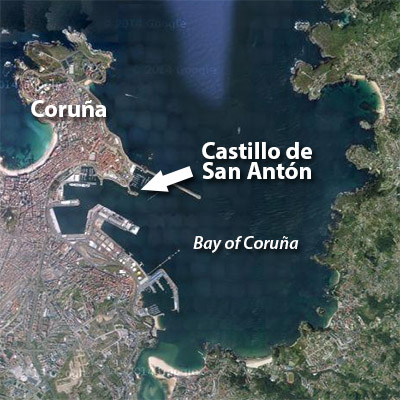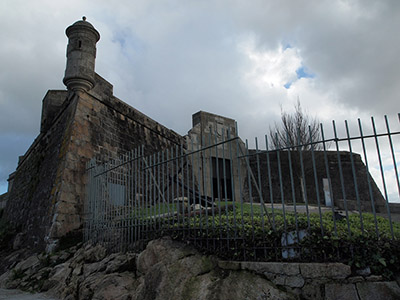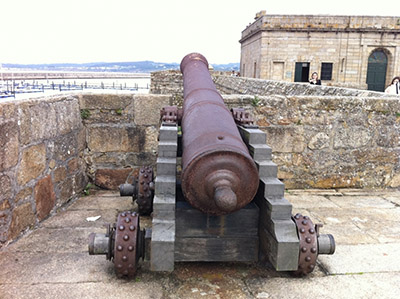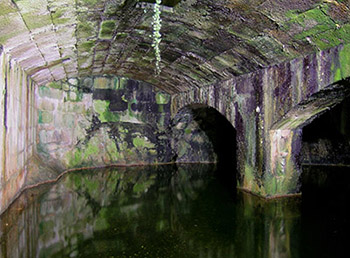 |
Castillo de San Antón
La Coruña, Galicia, Spain
|
|
 |
Constructed: 1587-1590
Used by: Spain
Conflict in which it participated:
Anglo-Spanish War (1585-1604)
|
The city of Coruña is at the northwest tip of Spain: In fact it's pretty much the northwest tip of Europe! A Celtic people of the Castro Culture are thought to be the first folks to put down stakes there, as early as the 9th century BC.
The Castro folks probably called themselves something other than the Castro folks, but the only thing they left behind were hill forts, which they built to assert their dominance in regions that they colonized. When the Romans came along a few centuries later, they noted these forts, which they called castrum, after which they named the people who had come before. |
 |
 |
|
The Romans got to Coruña in the 2nd century BC, built a lighthouse known as the Tower of Hercules, and quickly established the city as an important link in their maritime trade empire. After the fall of the Roman Empire in the 5th century, Coruña bobbed and weaved its way through attacks from Normans, Vikings and the Moorish Horde.
It wasn't until 991 that it occurred to anyone that a fort or two along the coast might not be a terrible idea. Coruña's first permanent fortification was built atop the ruins of the Tower of Hercules (Lighthouse fans need not despair: the Tower of Hercules was soon restored, and today proudly stands, emitting heroic light, serving whatever purpose lighthouses serve in the 21st century).
|
 Intimidating! Unless you're in a ship built after 1700. |
 |
In the approximate center of the Bay of Coruña was the small island of Lazaretto, where there was a chapel dedicated to Saint Antón (patron saint of amputees, protector of animals, weavers of baskets, manufacturers of brushes, butchers, gravediggers, hermits, monks, swineherds, those suffering from eczema, epilepsy, ergotism, erysipelas and skin diseases in general). This island was used as a quarantine location for sailors coming in from exotic ports with exotic diseases, and locals suffering from leprosy.
As early as 1528, local authorities were pointing at Lazaretto and saying things like, "Man would that be a great spot for a fort," though they likely would have said this in Spanish. 'Twas upon this island that the Castillo de San Antón was built, starting in 1587, under the direction of a Lieutenant Pedro Rodriguez.
|
|
|
From 1581 to 1714, Spain controlled the Spanish Netherlands, which today is Belgium and Luxembourg, plus parts of northern France and Germany. This was very close to Great Britain, which took a dim view indeed of such Spanish continental tomfoolery. Aggressive British naval pokings in the region at the beginning of the undeclared Anglo-Spanish War (1585-1604) convinced Spanish King Philip II (1527-1598) that Great Britain, with its recent Protestant ridiculousness, needed to be put down.
Elaborate plans to invade Britain were delayed when famed British privateer Sir Francis Drake (1540-1596) "Singed the King of Spain's Beard" by messing up the Spanish fleet at Cádiz in April and May of 1587. Masons working on the Castillo de San Antón surely watched in open-mouthed admiration when the Spanish Armada departed the Bay of Coruña in July of 1588, on its way to pick up troops in the Netherlands, then lumberingly swoop down onto England to majestically restore Catholicism to its rightful place on the throne.
|
Anyone who paid even the slightest smidgen of attention in history class knows that this did not occur. The sluggish Armada was savaged by the more nimble British Royal Navy at the Battle of Gravelines on July 28, 1588, then blundered into the North Atlantic, where it was mostly blown by storms onto the rocks of Ireland. See ya, Armada.
The "English Armada," under Sir Francis Drake again, attempted to do away with what was left of the Spanish Navy in May of 1589, much of which was refitting in the Bay of Coruña.
|
 |
The skinny little inside of the Castillo de San Antón: Casemates, casemates, casemates! |
|
Though not yet complete, the Castillo de San Antón was fully manned, and helped to deflect the British attack. Drake's fake Armada hung around off the coast of Spain until sickness and poor weather forced it to head back to England, unsuccessful in its Spanish-Navy-destroyin' goal.
|
 A gun at the Castillo de San Antón. Beware, Sir Francis Drake: We will run over your foot with one of these fashionably studded wheels! A gun at the Castillo de San Antón. Beware, Sir Francis Drake: We will run over your foot with one of these fashionably studded wheels! |
 |
The Castillo de San Antón was an early starfort. When it was built at the end of the 16th century, military engineers were busily copying the Trace Italienne, which was the cutting edge in fortification at that time. One problem that the Castillo faced after a century of bravely defending Coruña was that ships got bigger.
The squatty galleons that had comprised the Spanish Armada were thought to be the ultimate in naval design when the fort was designed in the 1580's, but by the beginning of the 18th century, most ships of war were taller than the walls of the Castillo! Starforts were so frequently built on commanding hills, overlooking that which they sought to defend, and the Castillo de San Antón was built on a low, little island that smelled of leprosy. |
|
|
Once a nation has made the vast expenditure of building and maintaining a starfort for a hundred years, however, it is unlikely to walk away from it just because it's a bit squatty. The Castillo de San Antón was used as a prison from the 18th century until 1960, plus the Governor's house was built within the fort's walls in the 1700's: As far as I can tell, this is the big rectangularish block that spans the fishy's (if we could all just please agree that this fort looks like a fishy) midsection. At some point the island of Lazaretto was joined to the mainland with "fill" to create a peninsula (likely so that the Governor wouldn't have to swim to his place), which today means that one gets to stroll through pretty gardens on their way to the Castillo.
Today, the Castillo de San Antón serves as Coruña's Museo Arquelógico, a museum dedicated to the Middle Ages and the modern city: Closed on Mondays.
|

When your fort is on a rock in the middle of a bay, it's unlikely that there'll be a source of fresh water handy. The Castillo de San Antón thus has this cistern, full of clear, delicious-looking drinking water.
|
 |
Those familiar with the Castillo de San Marcos will recognize the tilt of this wall and the dingleberry atop. The dingleberry is of course a Garita, whose utter ridiculousness I was forced to rethink when I experienced one in person. |
|
|
|
|
|
|
 |




